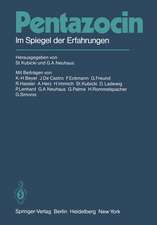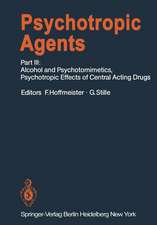Computational Toxicology: Methods and Protocols: Methods in Molecular Biology, cartea 2834
Editat de Orazio Nicolottien Limba Engleză Hardback – 21 oct 2024
Authoritative and cutting-edge, Computational Toxicology: Methods and Protocols, Second Editon aims to ensure successful results in the further study of this vital field.
| Toate formatele și edițiile | Preț | Express |
|---|---|---|
| Paperback (1) | 816.27 lei 38-44 zile | |
| Springer – 10 dec 2019 | 816.27 lei 38-44 zile | |
| Hardback (2) | 1118.02 lei 6-8 săpt. | |
| Springer Us – 21 oct 2024 | 1118.02 lei 6-8 săpt. | |
| Springer – 23 iun 2018 | 1317.33 lei 6-8 săpt. |
Din seria Methods in Molecular Biology
- 9%
 Preț: 791.59 lei
Preț: 791.59 lei - 23%
 Preț: 598.56 lei
Preț: 598.56 lei - 20%
 Preț: 882.95 lei
Preț: 882.95 lei -
 Preț: 252.04 lei
Preț: 252.04 lei - 5%
 Preț: 802.69 lei
Preț: 802.69 lei - 5%
 Preț: 729.61 lei
Preț: 729.61 lei - 5%
 Preț: 731.43 lei
Preț: 731.43 lei - 5%
 Preț: 741.30 lei
Preț: 741.30 lei - 5%
 Preț: 747.16 lei
Preț: 747.16 lei - 15%
 Preț: 663.45 lei
Preț: 663.45 lei - 18%
 Preț: 1025.34 lei
Preț: 1025.34 lei - 5%
 Preț: 734.57 lei
Preț: 734.57 lei - 18%
 Preț: 914.20 lei
Preț: 914.20 lei - 15%
 Preț: 664.61 lei
Preț: 664.61 lei - 15%
 Preț: 654.12 lei
Preț: 654.12 lei - 18%
 Preț: 1414.74 lei
Preț: 1414.74 lei - 5%
 Preț: 742.60 lei
Preț: 742.60 lei - 20%
 Preț: 821.63 lei
Preț: 821.63 lei - 18%
 Preț: 972.30 lei
Preț: 972.30 lei - 15%
 Preț: 660.49 lei
Preț: 660.49 lei - 5%
 Preț: 738.41 lei
Preț: 738.41 lei - 18%
 Preț: 984.92 lei
Preț: 984.92 lei - 5%
 Preț: 733.29 lei
Preț: 733.29 lei -
 Preț: 392.58 lei
Preț: 392.58 lei - 5%
 Preț: 746.26 lei
Preț: 746.26 lei - 18%
 Preț: 962.66 lei
Preț: 962.66 lei - 23%
 Preț: 860.21 lei
Preț: 860.21 lei - 15%
 Preț: 652.64 lei
Preț: 652.64 lei - 5%
 Preț: 1055.50 lei
Preț: 1055.50 lei - 23%
 Preț: 883.85 lei
Preț: 883.85 lei - 19%
 Preț: 491.88 lei
Preț: 491.88 lei - 5%
 Preț: 1038.84 lei
Preț: 1038.84 lei - 5%
 Preț: 524.15 lei
Preț: 524.15 lei - 18%
 Preț: 2122.34 lei
Preț: 2122.34 lei - 5%
 Preț: 1299.23 lei
Preț: 1299.23 lei - 5%
 Preț: 1339.10 lei
Preț: 1339.10 lei - 18%
 Preț: 1390.26 lei
Preț: 1390.26 lei - 18%
 Preț: 1395.63 lei
Preț: 1395.63 lei - 18%
 Preț: 1129.65 lei
Preț: 1129.65 lei - 18%
 Preț: 1408.26 lei
Preț: 1408.26 lei - 18%
 Preț: 1124.92 lei
Preț: 1124.92 lei - 18%
 Preț: 966.27 lei
Preț: 966.27 lei - 5%
 Preț: 1299.99 lei
Preț: 1299.99 lei - 5%
 Preț: 1108.51 lei
Preț: 1108.51 lei - 5%
 Preț: 983.72 lei
Preț: 983.72 lei - 5%
 Preț: 728.16 lei
Preț: 728.16 lei - 18%
 Preț: 1118.62 lei
Preț: 1118.62 lei - 18%
 Preț: 955.25 lei
Preț: 955.25 lei - 5%
 Preț: 1035.60 lei
Preț: 1035.60 lei - 18%
 Preț: 1400.35 lei
Preț: 1400.35 lei
Preț: 1118.02 lei
Preț vechi: 1176.86 lei
-5% Nou
Puncte Express: 1677
Preț estimativ în valută:
213.94€ • 223.93$ • 178.06£
213.94€ • 223.93$ • 178.06£
Carte tipărită la comandă
Livrare economică 31 martie-14 aprilie
Preluare comenzi: 021 569.72.76
Specificații
ISBN-13: 9781071640029
ISBN-10: 107164002X
Pagini: 508
Ilustrații: CDL, 450 p. 3 illus.
Dimensiuni: 178 x 254 mm
Greutate: 1.01 kg
Ediția:2nd ed. 2024
Editura: Springer Us
Colecția Humana
Seria Methods in Molecular Biology
Locul publicării:New York, NY, United States
ISBN-10: 107164002X
Pagini: 508
Ilustrații: CDL, 450 p. 3 illus.
Dimensiuni: 178 x 254 mm
Greutate: 1.01 kg
Ediția:2nd ed. 2024
Editura: Springer Us
Colecția Humana
Seria Methods in Molecular Biology
Locul publicării:New York, NY, United States
Cuprins
QSAR: Using the Past to Study the Present.- Molecular similarity in predictive toxicology with a focus on the q-RASAR technique.- Weight of Evidence: criteria and applications.- Integration of QSAR and NAM in the Read Across process for an effective and relevant toxicological assessment.- Automated workflows for data curation and machine learning to develop Quantitative Structure-Activity Relationships.- Applicability Domain for Trustable Predictions.- The potential of molecular docking for predictive toxicology.- Computational toxicology methods in chemical library design and high-throughput screening hit validation.- Toxicity potential of nutraceuticals.- Development, use and validation of (Q)SARs for predicting genotoxicity and carcinogenicity: experiences from Italian National Institute of Health activities .- Adverse outcome pathways mechanistically describing hepatotoxicity.- Machine learning in early prediction of metabolism of drugs.- In vitro cell-based MTT and Crystal Violet assays for drug toxicity screening.- Recent advances in nanodrug delivery systems production, efficacy, safety and toxicity.- Investigating the benefit-risk profile of drugs: from spontaneous reporting systems to real word data for pharmacovigilance.- MolPredictX – a Pioneer Mobile App Version for Online Biological Activity Predictions by Machine Learning Models.- TIRESIA and TISBE, explainable artificial intelligence based web platforms for the transparent assessment of the developmental toxicity of chemicals and drugs.- PFAS-Biomolecule Interactions: Case Study Using Asclepios Nodes and automated Workflows in KNIME for Drug Discovery and Toxicology.
Textul de pe ultima copertă
This second eidtion explores new and updated techniques used to understand solid target-specific models in computational toxicology. Chapters are divided into four sections, detailing molecular descriptors, QSAR and read-across, molecular and data modeling techniques, computational toxicology in drug discovery, molecular fingerprints, AI techniques, and safe drug design. Written in the highly successful Methods in Molecular Biology series format, chapters include introductions to their respective topics, lists of the necessary materials and reagents, step-by-step, readily reproducible laboratory protocols, and key tips on troubleshooting and avoiding known pitfalls.
Authoritative and cutting-edge, Computational Toxicology: Methods and Protocols, Second Editon aims to ensure successful results in the further study of this vital field.
Authoritative and cutting-edge, Computational Toxicology: Methods and Protocols, Second Editon aims to ensure successful results in the further study of this vital field.
Caracteristici
Includes cutting-edge methods and protocols Provides step-by-step detail essential for reproducible results Contains key notes and implementation advice from the experts






















